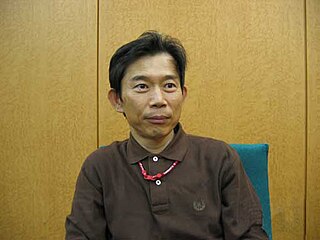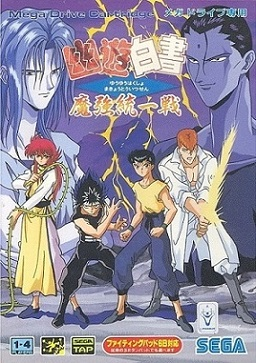
The Dreamcast is a home video game console released by Sega on November 27, 1998, in Japan; September 9, 1999, in North America; and October 14, 1999, in Europe. It was the first sixth-generation video game console, preceding Sony's PlayStation 2, Nintendo's GameCube, and Microsoft's Xbox. The Dreamcast was discontinued in 2001, ending Sega's 18 years in the console market.

Columns is a match-three puzzle video game released by Sega in 1990. Designed by Jay Geertsen, it was released by Sega for arcades and then ported to several Sega consoles. The game was subsequently ported to home computer platforms, including the Atari ST.

Segata Sanshiro is a character created by Sega to advertise the Sega Saturn in Japan between 1997 and 1998. He is a parody of Sugata Sanshirō, a legendary judo fighter from Akira Kurosawa's 1943 film Sanshiro Sugata. In television and radio advertisements, Segata Sanshiro is portrayed by actor Hiroshi Fujioka. He was positioned as a martial artist who commanded people to play Sega Saturn games.

Twinkle Star Sprites is a competitive vertically scrolling shooter arcade video game created by ADK and published by SNK in 1996. It was ADK's last production for the Neo Geo. Two players are each in separate, side-by-side, vertically scrolling levels. Combinations of shots and timed power-ups damage the other player. These attacks also serve as counters to the opponent's attack.

Sega Ages is a series of video game ports, remakes, and compilations published by Sega. It consists of Sega arcade games and home console games, typically those for the Sega Genesis and Master System. The series was launched on the Sega Saturn in 1996. Entries were published for the PlayStation 2 as Sega Ages 2500, a reference to its bargain ¥2500 price point. The series later came to the Xbox 360 and PlayStation 3 as Sega Ages Online, and finally to the Nintendo Switch as simply Sega Ages. The name Sega Ages is a palindrome, with "Ages" being "Sega" backwards — this was previously used by Sega in European marketing strategies from the late 1980s to early 1990s.

The Sega Genesis, also known as the Mega Drive outside North America, is a 16-bit fourth generation home video game console developed and sold by Sega. It was Sega's third console and the successor to the Master System. Sega released it in 1988 in Japan as the Mega Drive, and in 1989 in North America as the Genesis. In 1990, it was distributed as the Mega Drive by Virgin Mastertronic in Europe, Ozisoft in Australasia, and Tectoy in Brazil. In South Korea, it was distributed by Samsung Electronics as the Super Gam*Boy and later the Super Aladdin Boy.

Rad Mobile is a racing arcade game developed by Sega AM3 and published by Sega. It was first published in Japan in October 1990, followed by an international release for arcades in February 1991. Rad Mobile was Sega's first 32-bit game, using Sega's System 32 arcade system board. It was also the first appearance of Sonic the Hedgehog, who appears as an ornament hanging from the driver's rearview mirror.

Thunder Force IV, known in North America as Lightening Force: Quest for the Darkstar, is a shoot 'em up video game developed and published by Technosoft for the Mega Drive in 1992. It is the fourth installment in Technosoft's Thunder Force series, and the third and final one created for the Mega Drive. It was developed by the team at Technosoft that ported Devil's Crush to the Mega Drive rather than the team that developed the previous Thunder Force games. Like its predecessors, it is a horizontally scrolling shooter, but it also features extensive vertical scrolling with large playing fields.

Panorama Cotton is a 1994 rail shooter video game developed by Success and published by Sunsoft for the Mega Drive exclusively in Japan on August 12, 1994. Panorama Cotton is the third entry in the Cotton series and made a major departure from the original gameplay formula of prior Cotton entries; instead of being a side-scrolling shooter like the others, it is a pseudo-3D shooter in the style of Sega's Space Harrier.

Segagaga is a 2001 role-playing simulation video game developed by Hitmaker and published by Sega for the Dreamcast in Japan. Described as a "Sega simulation", the player takes control of Sega Tarō, who must help save a struggling Sega from losing to its rival DOGMA, who owns 97% of the console market. Gameplay involves battling employees and other characters throughout various Sega development studios, some being taken from older Sega game franchises. It features many tongue-in-cheek references to Sega and the video game industry, particularly Sony Computer Entertainment and its PlayStation 2 console.

Sega Power, initially known as S: The Sega Magazine, was a Future publication aimed at the Sega range of consoles, including the Master System, Mega Drive, Game Gear and later on the Mega-CD, 32X and Saturn. The magazine was later relaunched as Saturn Power when the other Sega consoles were discontinued.

Paragon Publishing Ltd was a magazine publisher in the UK, which published computer games and other entertainment titles from 1991 to 2003.

Sega Corporation is a Japanese multinational video game and entertainment company headquartered in Shinagawa, Tokyo. Its international branches, Sega of America and Sega Europe, are headquartered in Irvine, California, and London. Its division for the development of home video games, has existed in its current state since 2020; from 2015 to that point, the two had made up separate entities known as Sega Games and Sega Interactive Co., Ltd. Until 2024, Sega also handled amusement machine games. Sega is a subsidiary of Sega Sammy Holdings. From 1983 until 2001, Sega also developed video game consoles.

Hiroyuki Takahashi, is the president of the video game development studio Camelot Software Planning. He has participated in most of the company's projects as a game designer, producer, and writer.

The history of Sega, a Japanese multinational video game and entertainment company, has roots tracing back to American Standard Games in 1940 and Service Games of Japan in the 1950s. The formation of the company known today as Sega is traced back to the founding of Nihon Goraku Bussan, which became known as Sega Enterprises, Ltd. following the acquisition of Rosen Enterprises in 1965. Originally an importer of coin-operated arcade games to Japan and manufacturer of slot machines and jukeboxes, Sega began developing its own arcade games in 1966 with Periscope, which became a surprise success and led to more arcade machine development. In 1969, Gulf and Western Industries bought Sega, which continued its arcade game business through the 1970s.

Yu Yu Hakusho Makyō Tōitsusen is a 1994 fighting game developed by Treasure and published by Sega for the Mega Drive. It is based on the manga series Yu Yu Hakusho by Yoshihiro Togashi. The plot follows the protagonist Yusuke Urameshi, who is tasked by the ruler of the afterlife with solving detective-style cases involving both humans and demons threatening the living world. The story begins to focus heavily on martial arts battles as it progresses.

Sailor Moon is a side-scrolling beat 'em up video game originally developed and released by Angel in Japan on August 27, 1993 and later in France and Spain in November 1994 by Bandai for the Super Nintendo Entertainment System. It is the second game to be created by Angel based upon Naoko Takeuchi's Sailor Moon shōjo manga and anime series, the first for the Super NES and one of the few Sailor Moon titles that had an official international release.

Power Strike II is a 1993 vertically scrolling shooter video game developed by Compile and published by Sega for the Game Gear. An entry in the Aleste series, it is a follow-up to GG Aleste (1991). The game follows Alice Waizen piloting the Lance Bird space fighter craft to stop an unknown parasitic object attached to the armored defense satellite Algo. Its gameplay is similar to the previous Aleste entry on Game Gear, with the player fighting enemies and bosses, while avoiding collision with their projectiles and other obstacles.
















